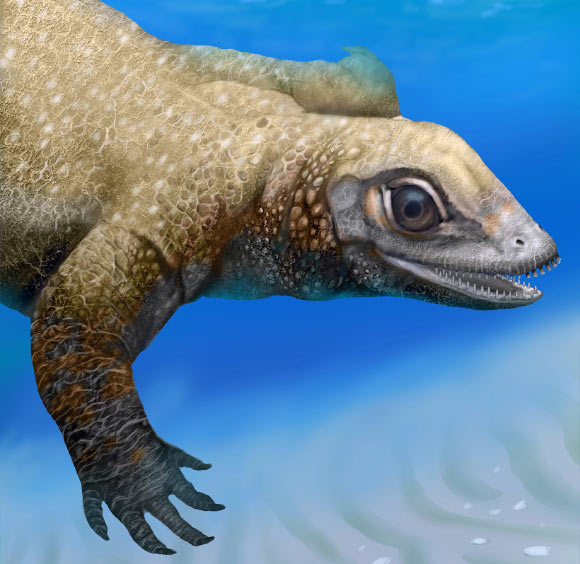A 246-million-year-old skull fossil found in Winterswijk, the Netherlands, sheds new light on the origin and phylogenetic development of placodonts, a group of marine reptiles that lived during the Triassic period.

Reconstruction of the juvenile placodont Palatodonta bleekeri (Jaime Chirinos)
For around 50 million years, placodonts populated the flat coastal regions of the Tethys Ocean, in modern day Europe and China.
The most distinctive feature of these creatures was their teeth: the upper jaw had two rows of flattened teeth – one on the palate and one on the jawbone, while the lower jaw only had one set of teeth ideal for crushing shellfish and crustaceans.
According to a research team led by Dr Torsten Scheyer, a paleontologist at the University of Zurich, the Winterswijk skull is the earliest form of all known placodonts.
The juvenile animal lived about 246 million years ago. At around 2 cm in size, the skull is exceptionally well preserved and its characteristics set it apart from previous placodont discoveries.
“The basal-most known placodonts to date have the group’s trademark double row of crushing teeth in the upper jaw. The flattened teeth that give these animals their name only appear in more derived placodonts.”
“Unlike all the other placodonts discovered to date, the Winterswijk specimen has conical, pointed teeth instead of flattened or ball-shaped crushing ones, which means the pointed teeth on the lower jaw slotted precisely into the gap between the palate and upper-jawbone teeth when biting,” said Dr Scheyer, who co-authored a paper in Nature Communications.
“The group’s trademark double row of teeth in the upper jaw is proof that the new find is actually a placodont. The teeth of Palatodonta bleekeri, the scientific name given to the Winterswijk specimen, were specialized in gripping and piercing soft prey.”

The newly found skull of a juvenile placodont from Winterswijk, the Netherlands (UZH)
“The double row of teeth in the new find combined with its considerable age lead us to conclude that it is a very early placodont, from which the later forms developed,” Dr Scheyer said. “The formation of crushing teeth and the specialization of a diet of shellfish and crustaceans thus developed later within placodont evolution.”
The small Palatodonta bleekeri skull sheds new light on the ongoing debate on where the placodonts originated: previous finds suggested origins in the shelf sea areas of either present-day China or Europe.
Due to the considerable age of the find and its basal form, however, the European origin of the placodonts is confirmed. The team is hoping for further exciting finds in Winterswijk to discover more about the evolution of placodonts.
______
Bibliographic information: James M. Neenan et al. 2013. European origin of placodont marine reptiles and the evolution of crushing dentition in Placodontia. Nature Communications 4, article number: 1621; doi: 10.1038/ncomms2633







